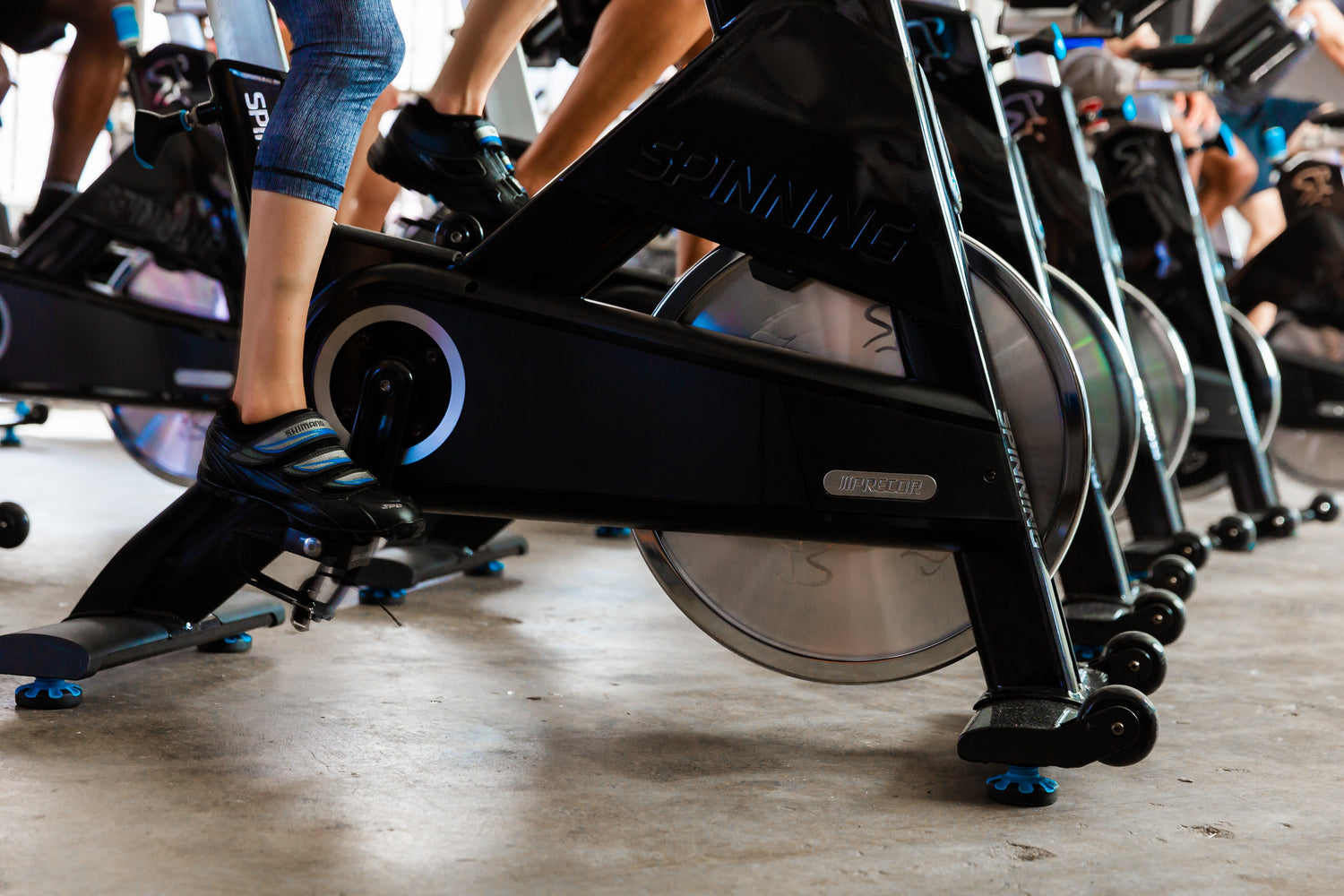Autism spectrum disorder affects millions of people around the world Learn how a Certified Spinning® Instructor who is on the autism spectrum brings the amazing benefits of Spinning® to this population.
Everyone – from an individual just starting their fitness journey to an athlete training for their next competition – can participate in the same Spinning® class and enjoy an incredible fitness experience. The Spinning® program provides instructors with education on how to accommodate every population so that riders from all walks of life can enjoy a heart-pounding class. That’s how I felt when I entered my first Spinning® class as a person with autism.
Autism is a disorder where the brain thinks and reacts a little differently than a neurotypical brain. According to Autism Speaks, 1 in 37 boys and 1 in 151 girls are on the autism spectrum, which includes a range of conditions like learning difficulties and problems socializing. Also, a third of children with autism are overweight, and 16 percent are obese (1). Thankfully, there are many resources to support people with this condition. I would not be writing this article today if I did not get these services when I was younger.
There are many physical, neurological and emotional benefits in Spinning® classes for people on the spectrum. First and foremost, Spinning® is a great physical activity that can lead to weight loss. I lost 30 pounds due to eating right and taking indoor cycling classes. Second, it increases serotonin levels in the brain, which boosts self-esteem and happiness (2). It also brings them a sense of community, as well as a way of bonding with other members and the instructor. I know that when I take a Spin® class, I always look for the sense of community.
Finally, people with learning difficulties due to autism may find Spinning® easy to follow. I know that when I take a class like kickboxing or dance format that moves quickly, I tend to not be able to follow along. Because of its repetitive, simple motions, people with Autism tend to pick up Spinning® more easily. It’s as easy as riding an outdoor bike, just as Johnny G intended it.
Daniel Stein is the Founder of Special Strong and Strong Education, two organizations that help people with mental and physical disabilities. He has served over 1,000 people who are on the spectrum, his biggest clientele. Along with focusing on the physical benefits of exercise like weight loss, the program also addresses maladaptive behaviors, like biting your nails or struggling to stay calm in public spaces. When we talked about training students with autism, Stein recalled working with this person who wouldn’t go to a restaurant for many years because of his difficulty with sensory overload in public spaces. Special Strong worked on that maladaptive behavior through personal training sessions, and on his parents’ anniversary, he was able to go to the restaurant with no problem!
I also asked Stein about his thoughts on what common modifications are good for a Spinning® class. He said that he has his own group fitness certification program called Strong Education that teaches group fitness instructors on how to modify workouts for people with autism. I also spoke with Dr. Alexander Lopez of Inclusive Sports and Fitness (ISF) and Associate Professor of Occupational Therapy at NYIT, and he also believes that anyone can participate in a Spin® class with maybe some slight modifications to the sound and lights. He insists on treating every student on the spectrum with the same tone and respect as other students, which will build more confidence.
Both Stein and Lopez believe that Spinning® is really easy to grasp for people on the spectrum. At ISF, they have a Spin® room with a Spivi® display. Students enjoy riding with these displays because they like seeing their avatar on the screen, and they are motivated to do the work. Using this system, participants are also able to track their data and progress in rides outside of indoor cycling class. Stein thinks it’s a great idea for people on the spectrum to try Spinning® because it helps with their sensory systems, and clipping/strapping into the pedals on the bike makes them feel like they are “locked in” to the effort.
Sometimes, people with autism need accommodations to feel comfortable in a Spinning® class. Here are some adjustments that may greater improve the experience for students on the spectrum:
- Lower the Music/Microphone Volume – One of the most common symptoms of autism is an over-sensitivity of the senses. As a result, the volume of the music and microphone in the Spinning® room may be too loud. So consider lowering the volume for students on the spectrum. Ear plugs are a great alternative for people with autism, and think about setting a good example in your form in case your students can’t hear your cues.
- Offer Rewards and Encouragement – Words of affirmation and encouragement are always welcome in class. Your members need to know that they are doing a great job, especially if they are on the spectrum, and it’s an easy way to keep them motivated. A person came into my class who isn’t on the spectrum appeared to be pedaling a little slower than the terrain or effort called for. I knew she could do better. I became more specific in my praise, like when she matched the cadence range that I cued, and she started to work hard for the rest of the class. I have found it’s equally powerful to praise the accomplishment of a maneuver or activity as well as the person’s effort. Sometimes, a variety of different types of encouragement will make a big difference! You can also reward your members on the spectrum by offering a prize box when they achieve their goals. Tangible rewards are another great way to keep students feeling empowered.
- Turn Off Strobing or Humming Lights – As mentioned earlier, people on the spectrum have a high sensitivity to their environments (3). Dr. Lopez suggested having the lights dimmed or even off to avoid any flickering or buzzing that can cause sensory overload.
- Break Down Your Instructions or Material – Learning difficulties are another common symptom of autism, so your students on the spectrum may need information broken down into clear chunks, or directions need to be stated in clear steps.
- Repeat and Reinforce – With those learning difficulties come a shorter attention span, so give more cues and repeat instructions until the movement is learned. Some students may also want to know what is coming next, so remember to announce the next effort, terrain change or recovery period in class.
- Employ Visual Cues – Another symptom of autism is difficulty with language, so use some visual cues like hand motions. And be sure to set a great example with your form and technique.
I remember walking into a Spin® class for the first time just expecting to get a good workout, but I got so much more. I felt a sense of community that was unlike anything I’ve ever experienced. Everyone was extremely welcoming and helpful, particularly the instructor. As I started taking classes regularly, the cues became more and more familiar to me. The instructor was extremely encouraging and energetic. But most importantly, she believed in me. When I approached her and asked her if she thought I could become a Spin® instructor, she said, “absolutely!” When I started training for my certification, I realized that I can really make a difference for people in the community who are on the spectrum. I am grateful to have Master Instructor Heather Anderson-Santin lead my live training day because she gave me the skills and confidence to be able to teach a class.
Students with autism can enjoy classes if the instructor is aware and willing to make accommodations that would make students feel more comfortable and willing to participate. So I encourage you to look out for these students in class, because people with autism can benefit greatly from Spinning® classes.
Please consider donating to Autism Speaks or your local grassroots organization. And what do you think are ways we can reach people on the spectrum in our classes? Share them in the comments below!
This article was contributed by Matthew Alexander.
REFERENCES
(1) “Autism Facts and Figures.” Autism Speaks, Autism Speaks, https://www.autismspeaks.org/autism-facts-and-fig...
(2) Hamedinia, M., Sharifi, M., & Hosseini-Kakhak, A. (2017). The effect of eight weeks of aerobic, anaerobic and resistance training on some factor of endocannabinoid system, serotonin, beta-endorphin and BDNF in young men. Biosciences Biotechnology Research Asia, 14(3), 1201-1210. doi:http://dx.doi.org/10.13005/bbra/2562
(3) Rudy, Lisa Jo. “Your Autistic Child's Melt Down May Be From Sensory Overload.” Verywell Health, Verywell Health, 19 Sept. 2019, Found at: https://www.verywellhealth.com/autism-and-sensory...





Leave a comment
This site is protected by hCaptcha and the hCaptcha Privacy Policy and Terms of Service apply.